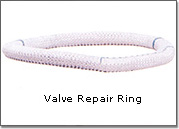| |
Cardiac
Thoracic - Cardiac Valve Surgery
Mitral Valve Repair
 During
valve repair, parts of a stenotic valve that are stiff
or hardened may be cut and separated to help them
open wider. Parts of an insufficient valve may be
strengthened and shortened to help the valve close
more tightly. Through valve repair, the natural anatomy
of the heart valves is maintained. During
valve repair, parts of a stenotic valve that are stiff
or hardened may be cut and separated to help them
open wider. Parts of an insufficient valve may be
strengthened and shortened to help the valve close
more tightly. Through valve repair, the natural anatomy
of the heart valves is maintained.
Mitral Valve repair has distinct
benefits:
- Retains the patients natural valve
- No life long anticoagulation treatment
Valve Replacement (Aortic, Mitral
& Tricuspid)
 If
a valve can't be repaired, it may be replaced with
a prosthetic valve. Two kinds of prosthetic heart
valves are available. If
a valve can't be repaired, it may be replaced with
a prosthetic valve. Two kinds of prosthetic heart
valves are available.
- Mechanical valves are created from manmade materials.
Lifetime therapy with anticoagulant medication,
to prevent blood clots on or around the valve, is
necessary when these types of valves are used.
- Biological (tissue) valves are taken from pig,
cow, or human donors. Biological valves don't last
as long as mechanical valves. However, when biological
valves are used, long-term therapy with anticoagulant
medication often isn't necessary.
The surgeon discusses which type
of valve is best for you. Factors considered are your
age, occupation, the size of your valve, how well
your heart is working, your heart's rhythm, your ability
to take anticoagulant medications, and how many new
valves you need.
|